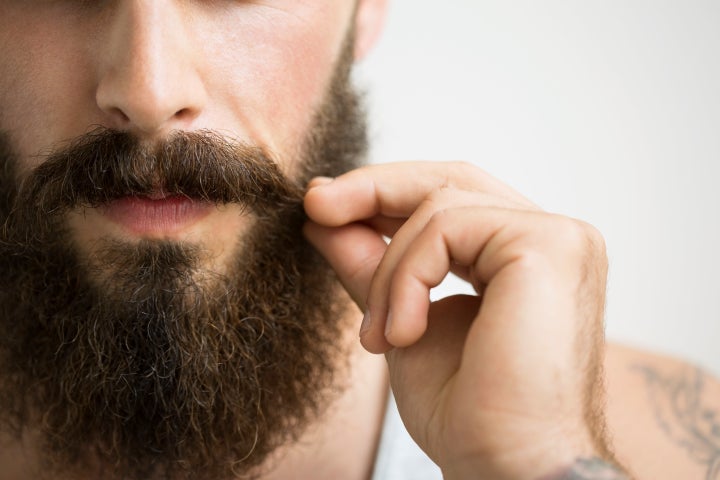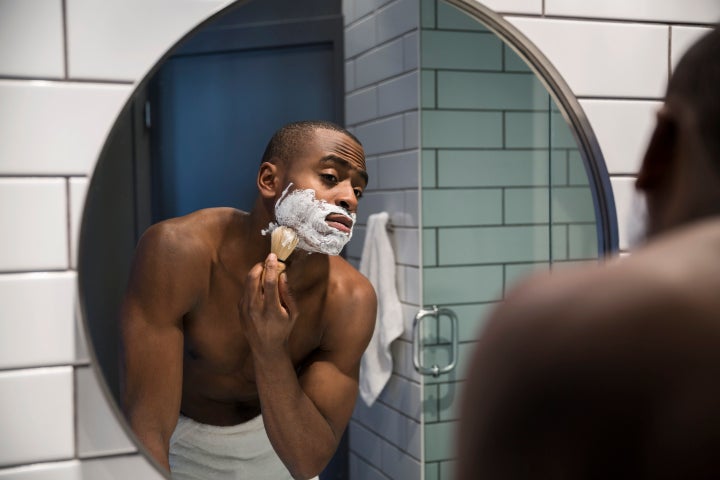According to a recent study from the Hirslanden Clinic in Switzerland, men’s beards carry more bacteria ― some of which could be harmful to health ― than the hair of dogs.
Sounds pretty gross, right? Well, bearded men shouldn’t panic just yet. It should be noted that this particular study was extremely small and the sample groups weren’t equal; 18 men were tested versus 30 dogs. The researchers based their conclusion on the fact that every single man tested had high counts of bacteria living in their beards, while only 23 of the dogs had the same levels. So while there were more dogs with high bacteria counts than men, percentage-wise, 100% of men had high counts compared with about 77% of the dogs.

The cleanliness of beards has long been a topic of debate, as people question things like whether beards carry more traces of poop than a toilet. For the record, it’s true that beards carry bacteria, but it’s not necessarily a cause for major concern.
That doesn’t mean you should neglect taking care of your beard, though. In order to maintain a happy, healthy beard (and skin in the area), you need to put in a little bit of work. We spoke to grooming experts and a dermatologist to share their best beard tips. Read on to find out what they had to say.
First, let’s talk about bacteria.
“We have normal organisms that live on our skin, and I think a misconception a lot of the time is that these organisms, including bacteria, are bad,” Dr. Forum Patel, a New York-based dermatologist, told HuffPost.
In her opinion, it’s not necessarily accurate to say humans, or specifically their beards, are dirtier than dogs, “because we’re exposed to different environments.”
“We have a lot of bacteria that live on our skin,” she added. “But we need it there, it’s there for a reason.”
In fact, the bacteria that live on our skin are part of what’s called the skin’s microbiome. Many of these bacteria have been found to be quite helpful; one study suggested they can help protect against cancer, while another said that bacteria could help speed up the healing process.
Still, you need to wash your beard.
This one might seem like a no-brainer, but washing your beard is important for getting unwanted germs out.
“Men should be washing their beards as often as they wash their hair,” Patel told HuffPost. “They should be treating it just like the hair on their heads.”
For example, she said, if someone sweats enough during a workout (or other activity) that they need to wash the hair on their head, “the same applies to your beard.”
Mikka Gia, owner and head barber at The Groomed Society in Toronto, Canada, suggested washing a beard two to three times a week using a beard shampoo.
“Beard shampoos are generally milder than hair shampoo, as facial skin can be quite sensitive,” Gia said. “For convenience, there are beard shampoos or washes that are made for use on both the face and hair.”
If you’re super stuck and unable to wash your beard for whatever reason, Xavier Cruz, owner of Barba Men’s Grooming Boutique in New York, said to give your beard “a good brushing.”
“This certainly isn’t a substitute for washing, but it helps for the moment,” Cruz said.
Try a beard oil.
After washing your beard, Gia suggested, apply a little bit of beard oil, as it “promotes hydration and adds shine and control.”
The key is not applying too much, as it can lead to oil buildup on the hair and skin, which could lead to a greasy-feeling face, Gia said. Remember, you can always add a bit more as you go. She added that she prefers shampoos and oils with natural ingredients that are easy to pronounce.
(Amazon reviewers really seem to love this $13.25 beard shampoo by Professor Fuzzworthy’s and, at this week’s price, $12 Honest Amish beard oil.)
The best time to apply beard oils, according to Cruz, is right after washing.
“This allows quick absorption, as the cuticle is still open from the warm wash,” he said.
Make sure you dry your beard.
You might not think about taking a blow dryer to your beard, but it might actually do you some good.
As Patel noted, one issue with beards, especially when they’re on the thicker, denser side, is that it’s really hard to dry them.
″You have a moist environment, and if you’re not really drying it after washing, that can harbor a lot of organisms, regardless of if they’re going to cause issues or not,” Patel said.
Basically, Patel agreed a damp beard is a ripe environment for bacteria to thrive.

Stop shaving against the grain.
By now we know that most of the bacteria on our skin are harmless. However, there is a chance they can lead to infections, particularly from improper shaving, Patel said.
If you’re using a bad razor or “don’t have the best shaving technique,” Patel said you’re creating micro-cuts in the skin, potentially giving the bacteria an entry point to case an infection.
“When we talk about these organisms, they’re in three different categories: bacteria, fungus and viruses,” Patel said. “Usually, when the skin is intact, those things are harmless. As soon as there’s some sort of micro-cut or damage that [can be] caused by shaving, that’s when it becomes a problem.”
And for the record, the best way to shave to prevent unwanted micro-cuts or irritation is with the grain.
One common issue Patel said she sees in bearded patients is folliculitis, which is essentially an inflammation of the hair follicle. Men are more prone to it because they tend to have more facial hair and their hair follicles are coarser than those women might have.
“Because of that, just having hair grow back in the skin forms this innate inflammation,” Patel said. “Sometimes that can get infected with the bacteria that live on our skin.”
Trim regularly.
This point is more for the look of the beard than cleanliness, but Cruz noted that regular trims “are just as important as haircuts.”
“Beard whiskers can split just like hairs on the head,” he said. “It’s necessary to trim those ends to keep them healthy. We suggest a biweekly trim.”
If you’re dealing with a flaky beard, try some dandruff shampoo.
Aside from the bacteria that live on our skin, there’s also a type of yeast present. That yeast, which Patel said is usually normal, leads to dandruff.
“Because the bearded areas are so dense, those areas are more prone to getting dandruff, which can really irritate your skin if it’s not treated properly,” she said. “I particularly tell my patients to pick up Head and Shoulders and use that not only as a shampoo but also a face wash and over their beard.”
This method might not be a solution for everyone, but if you think it might help you, it’s best to consult a dermatologist.
Both long and short beards require maintenance.
Cruz and Gia agreed that long and short beards need to be washed and groomed. However, Gia noted that long beards do require a little more maintenance.
“Shorter beards still require maintenance, but washing and oiling can take less time as the beard is shorter and closer to the face and [likely requires] less product,” Gia said. “If you regularly groom and maintain your beard, you’ll look great, no matter the length.
Don’t be afraid to ask a barber for help.
If you’re new to the whole beard care thing, Gia said the best thing you can do is ask a barber for advice.
“Find a great barber who knows beards, face shapes and products,” Gia said. “Ask them to demonstrate how to wash and oil your beard. Also ask about how much shampoo or oil to use, especially if you’re unsure of how much to apply.”
Once you’ve got a routine, Gia said, stick with it “and you’ll always have a happy face and gorgeous beard.”
